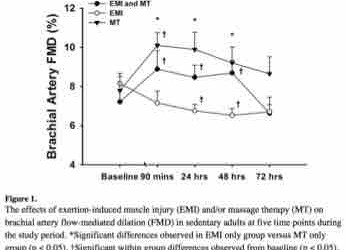ref: Arch Phys Med Rehabil. 2014 Jun; 95(6): 1127–1134
This study, a randomised controlled one was conducted to determine if lower extremity exercise-induced muscle injury (EMI) reduces vascular endothelial function of the upper extremity and if massage therapy (MT) improves peripheral vascular function after EMI. Thirty-six sedentary young adults were randomly assigned to one of three groups: 1) EMI + MT (n=15; mean age ± standard error (SE): 26.6±0.3), 2) EMI only (n=10; mean age ± SE: 23.6±0.4), and 3) MT only (n=11; mean age ± SE: 25.5 ± 0.4). Brachial artery flow-mediated dilation (FMD) was determined by ultrasound at each time point. Nitroglycerin-induced dilation was also assessed (NTG; 0.4 mg). Brachial FMD increased from baseline in the EMI + MT group and the MT only group (7.38±0.18 to 9.02±0.28%, p<0.05 and 7.77±0.25 to 10.20±0.22%, p < 0.05, respectively) at 90 minutes remaining elevated until 72 hrs. In the EMI only group FMD was reduced from baseline at 24 and 48 hrs (7.78±0.14 to 6.75±0.11%, p<0.05 and 6.53±0.11, p<0.05, respectively) returning to baseline after 72 hrs. Dilations to NTG were similar over time.
Those are very interesting results to the importance of massage therapy in this group of patients, and deserve further in depth look to understand the implication of this in the real life practice. http://www.ncbi.nlm.nih.gov/pmc/articles/PMC4037335/

